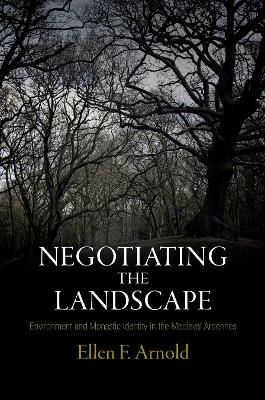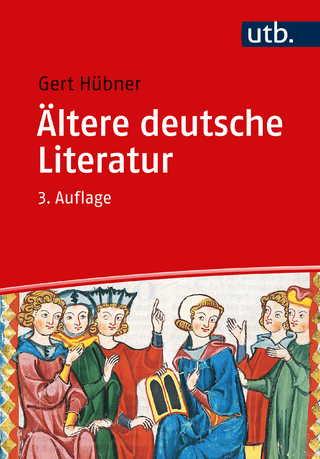
Negotiating the Landscape
Environment and Monastic Identity in the Medieval Ardennes
Seiten
2012
University of Pennsylvania Press (Verlag)
978-0-8122-4463-2 (ISBN)
University of Pennsylvania Press (Verlag)
978-0-8122-4463-2 (ISBN)
Ellen Arnold draws upon a rich archive of charters, property and tax records, correspondence, miracle collections and saints' lives to explore the ways in which interaction with the natural world affected the 'environmental imagination' and identity of the Benedictine monks of Stavelot-Malmedy in the medieval Ardennes.
Negotiating the Landscape explores the question of how medieval religious identities were shaped and modified by interaction with the natural environment. Focusing on the Benedictine monastic community of Stavelot-Malmedy in the Ardennes, Ellen F. Arnold draws upon a rich archive of charters, property and tax records, correspondence, miracle collections, and saints' lives from the seventh to the mid-twelfth century to explore the contexts in which the monks' intense engagement with the natural world was generated and refined.
Arnold argues for a broad cultural approach to medieval environmental history and a consideration of a medieval environmental imagination through which people perceived the nonhuman world and their own relation to it. Concerned to reassert medieval Christianity's vitality and variety, Arnold also seeks to oppose the historically influential view that the natural world was regarded in the premodern period as provided by God solely for human use and exploitation. The book argues that, rather than possessing a single unifying vision of nature, the monks drew on their ideas and experience to create and then manipulate a complex understanding of their environment. Viewing nature as both wild and domestic, they simultaneously acted out several roles, as stewards of the land and as economic agents exploiting natural resources. They saw the natural world of the Ardennes as a type of wilderness, a pastoral haven, and a source of human salvation, and actively incorporated these differing views of nature into their own attempts to build their community, understand and establish their religious identity, and relate to others who shared their landscape.
Negotiating the Landscape explores the question of how medieval religious identities were shaped and modified by interaction with the natural environment. Focusing on the Benedictine monastic community of Stavelot-Malmedy in the Ardennes, Ellen F. Arnold draws upon a rich archive of charters, property and tax records, correspondence, miracle collections, and saints' lives from the seventh to the mid-twelfth century to explore the contexts in which the monks' intense engagement with the natural world was generated and refined.
Arnold argues for a broad cultural approach to medieval environmental history and a consideration of a medieval environmental imagination through which people perceived the nonhuman world and their own relation to it. Concerned to reassert medieval Christianity's vitality and variety, Arnold also seeks to oppose the historically influential view that the natural world was regarded in the premodern period as provided by God solely for human use and exploitation. The book argues that, rather than possessing a single unifying vision of nature, the monks drew on their ideas and experience to create and then manipulate a complex understanding of their environment. Viewing nature as both wild and domestic, they simultaneously acted out several roles, as stewards of the land and as economic agents exploiting natural resources. They saw the natural world of the Ardennes as a type of wilderness, a pastoral haven, and a source of human salvation, and actively incorporated these differing views of nature into their own attempts to build their community, understand and establish their religious identity, and relate to others who shared their landscape.
Ellen F. Arnold teaches history at Ohio Wesleyan University.
Introduction: Approaching the Medieval Landscape 1
Chapter 1. Religious Roots: Foundation in the ''Forest Wilderness'' 31
Chapter 2. Controlling the Domesticated Landscape: Value, Ownership, and Religious Interpretations 62
Chapter 3. Fighting over Forests: Establishing Social and Religious Authority 110
Chapter 4. Creating Conflict: Forests in the Monastic Imagination 145
Chapter 5. The Religious Landscape and Monastic Identity 173
Epilogue: The Passio Agilolfi Revisited 213
Timeline 219
Handlist of Sources 223
Notes 227
Bibliography 271
Index 289
Acknowledgments 299
| Erscheint lt. Verlag | 28.12.2012 |
|---|---|
| Reihe/Serie | The Middle Ages Series |
| Zusatzinfo | 2 maps |
| Verlagsort | Pennsylvania |
| Sprache | englisch |
| Maße | 152 x 229 mm |
| Themenwelt | Geschichte ► Allgemeine Geschichte ► Mittelalter |
| Geisteswissenschaften ► Geschichte ► Regional- / Ländergeschichte | |
| Geschichte ► Teilgebiete der Geschichte ► Religionsgeschichte | |
| Religion / Theologie ► Christentum ► Kirchengeschichte | |
| ISBN-10 | 0-8122-4463-X / 081224463X |
| ISBN-13 | 978-0-8122-4463-2 / 9780812244632 |
| Zustand | Neuware |
| Haben Sie eine Frage zum Produkt? |
Mehr entdecken
aus dem Bereich
aus dem Bereich
eine neue Geschichte des Mittelalters
Buch | Hardcover (2023)
C.H.Beck (Verlag)
38,00 €


